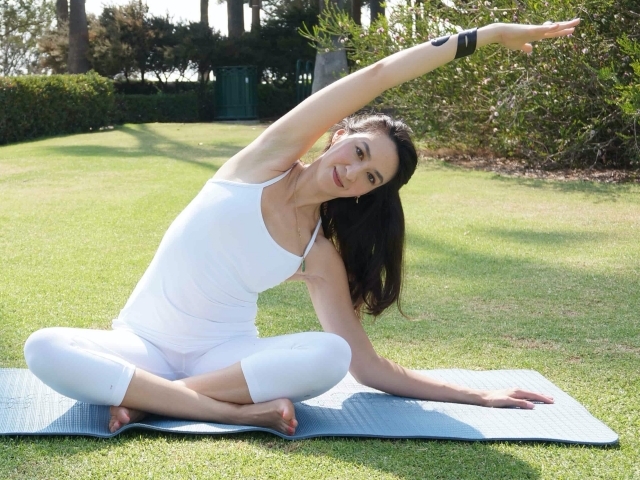Apart from mindful eating and identifying the food items that cause digestive issues, it is important to incorporate asana, proper sitting posture, the right sleeping position to have a positive impact on digestion and gut health. This is because Yoga poses help to stretch the muscles, massage the internal organs and stimulate the digestive system.
The digestive system or digestive tract comprises of the mouth, oesophagus, stomach, pancreas, liver, gallbladder, small intestine, colon and rectum. This complex and interconnected mesh of organs form the gut or our gastrointestinal system. Exercise is crucial as it ensures gut health by targeting the stomach, small intestine, large intestine and the liver meridians. Here are a few simple Yoga Poses for an effective digestive system.
- Seated Side Bend
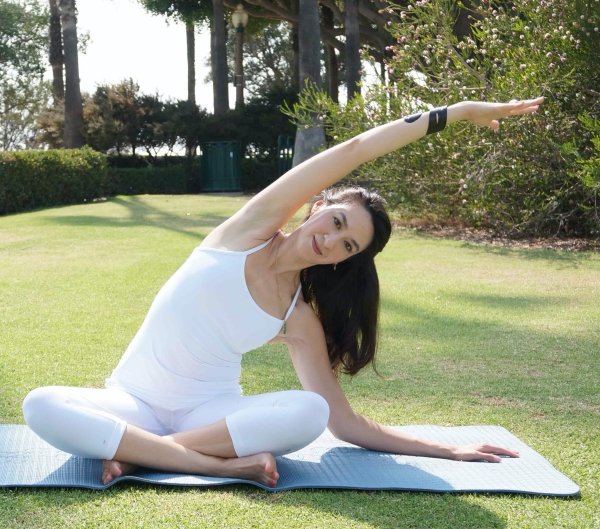
This is a great beginner move for people looking to stretch their oblique’s, belly muscles, lower and upper back, and shoulders. The gentle stretch may help alleviate bloating and gas and support general digestion.
Instructions:
- Sit on the floor in a cross-legged position, with your hands touching the floor at your sides.
- Raise your left arm straight into the air, and then gently lean to your right side.
- Keep your right forearm on the floor, facing outward.
- Slowly breathe in and out 4–5 times. Then, switch sides and repeat.
- Seated Twist
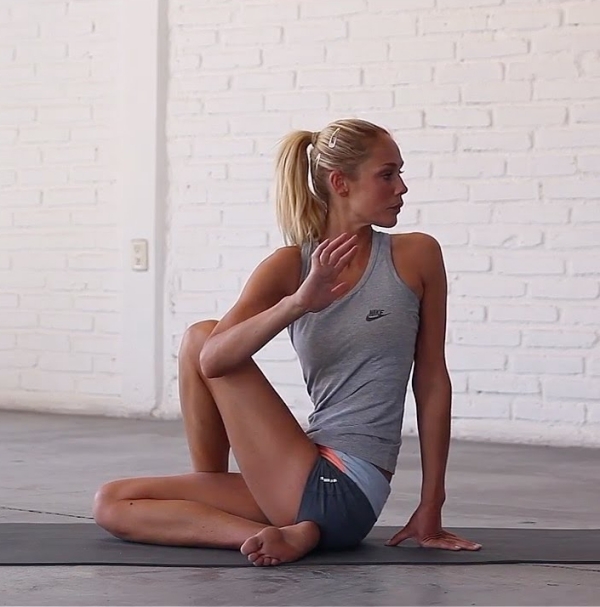
The twisting motion of this move is thought to promote bowel regularity by aiding the small and large intestine in peristalsis. This is the movement that propels food and waste through the GI tract.
Instructions:
- Sit on the floor, with both legs straight. Bend your left knee and cross it over your right knee or thigh, placing your left foot on the floor. Keep your left foot planted throughout the entire movement.
- Then gently lean on your right hip and bend your right knee so that the sole of your right foot is facing inward toward your left buttock. If this is too difficult, you can keep your right leg straight.
- Take your right elbow and place it on the outside of your left knee while you gently rotate your trunk to the left. Place your left palm on the floor to the left of your buttocks.
- Turn your neck so it is slightly looking over your left shoulder.
- Hold this position and breathe for 4–5 deep breaths. With each breath, notice your spine elongating. Then, switch sides and repeat.
- Supine Spinal Twist
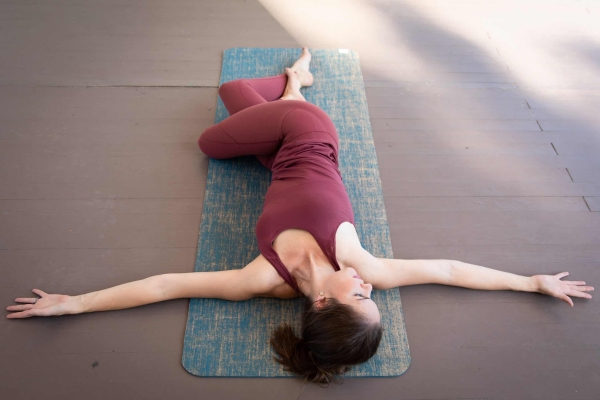
Supine Spinal Twist Pose is great for stretching the lower back and increasing spinal mobility. People believe it alleviates constipation and bloating and supports general digestion.
Instructions:
- Lie down on your back, also called supine position.
- Bend both knees, with the soles of your feet flat on the floor. Lift your hips 1–2 inches (2.5–5 cm) off the ground and shift them to the right about 1 inch (2.5 cm). This will allow your hips to stack when completing this move. Lower your hips back to the floor.
- Straighten your left leg and grab your right knee and bring it toward your chest.
- While keeping your left leg straight, gently rotate to the left and bring your right knee over your left. Instead of forcing your knee to the ground, allow it to gently drape over your left leg.
- Bring your right arm back and place it straight on the floor, perpendicular to your body. Take your left hand and gently press on your right knee for a greater stretch. Alternatively, leave your left arm straight.
- Hold this position for 4–5 deep breaths. Then, repeat on the other side.
- Knees to Chest
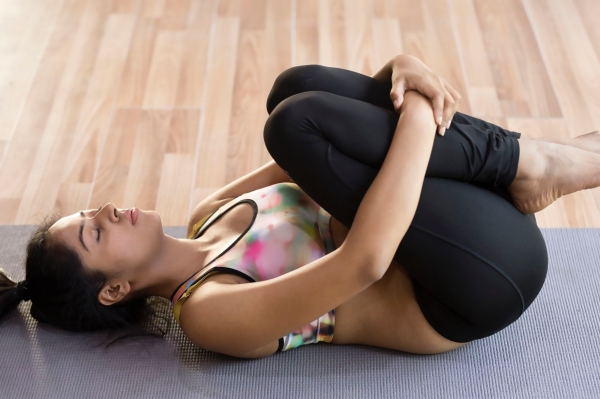
Knees to Chest is a gentle movement that can be relaxing and relieve lower back strain. Proponents say it gently massages the large intestine to promote bowel movements.
Instructions:
- Lie on your back, in supine position, with your legs straight.
- Slowly bend your knees and bring them toward your chest, using your arms to pull them closer.
- Hold this position for 4–5 deep breaths.
- Cat-Cow
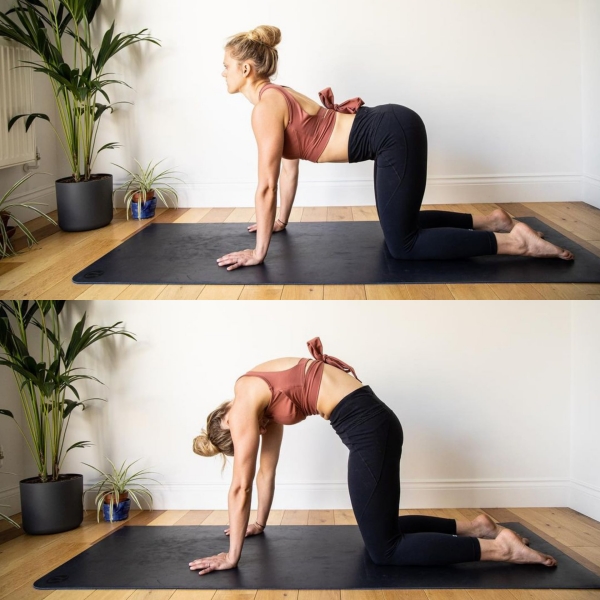
Cat-Cow Pose transitions between two classic yoga positions: Cat Pose and Cow Pose. Together, they can stretch your back and belly muscles. Proponents say these poses improve circulation and gently massage your organs to promote gut peristalsis.
Instructions:
- Start on your hands and knees with a neutral spine — that is, with a flat back and neck. Make sure your knees are aligned with your hips and your wrists are aligned with your shoulders.
- Begin by entering cow pose. To do this, tilt your pelvis so that your tailbone goes up and your belly moves down. Be sure to engage your core.
- Gently roll your shoulders back and raise your head by looking upward. Make sure to avoid overextending your neck.
- Hold for 4–5 breaths.
- Next, return to neutral position.
- To enter cat pose, place the tops of your feet on the floor with the soles of your feet facing upward. Tuck in your tailbone, draw your belly button towards your spine, and roll your shoulders forward so that you’re arching your back.
- Gently lower your head, allowing gravity to control this instead of forcing it down.
- Hold for 4–5 breaths.
- Repeat this 2–3 times.
- Cobra Pose

Cobra Pose mimics a cobra in its upright position. It helps stretch your belly muscles and improve posture, and proponents say it supports general digestion.
Instructions:
- Start by lying on your stomach, with your feet hip-width apart and the palms of your hands flat on the floor by your lower ribs, elbows bent.
- Extend your feet so that the tops of your feet are touching the ground.
- Press into your hands and slowly bring your head and chest upward. Keep your elbows slightly bent as you slowly straighten your arms. Roll your shoulders back and down. Focus on lifting your sternum rather than raising your chin.
- Be sure to keep your pelvis on the floor and focus on bringing your chest and upper back up and forward.
- Look upward slightly without overextending your neck or raising your chin. Hold for 4–5 breaths.
